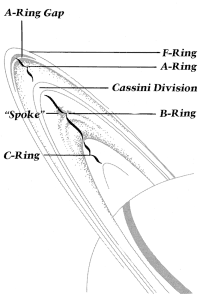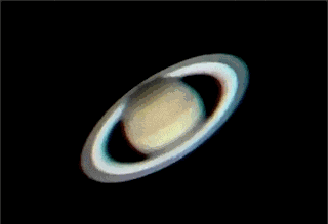Touring Saturn's Rings
Jack Kramer
Telescopes of the early 17th Century were so crude that Galileo never had a clear view of Saturn's rings. Nonetheless, this planet did not look to him at all like the others - it appeared as one bright star closely flanked by two dimmer ones. He wanted to announce this amazing observation, but keep his work secret while he studied the planet further. So he published his discovery in code: smais mr milmep oet ale umibunen ugttauir as. Translated, this anagram means "I have observed the highest planet tri-form." Finally in 1616 Galileo detected that "The two companions are no longer two small perfectly round globes ... but are present much larger and no longer round ... that is, two half ellipses with two little dark triangles in the middle of the figure and contiguous to the middle globe of Saturn, which is seen, as always, perfectly round". Apparently, he still had not recognized them as rings encircling the planet. Their nature must have been a source of continuing vexation to him.
It was left for later observers of Saturn to determine that this was a ring system. In 1675 Giovanni Cassini discovered a gap in the rings which would later be named after him. He was using a telescope of about 21/2" aperture, working at 90x. The outer ring would be called the A ring and the brighter inner ring would be called the B ring.
Saturn's rings are 250,000 km wide, but only a few tens of meters thick. Stated another way, if you were to make a 1-meter-wide scale model of Saturn, the rings would be 10,000 times thinner than a razor blade! It's amazing that they stand out so well in our telescopes. Today just about any telescope will show the rings and the Cassini division. The real trick is to see how much additional detail you can see in the rings.
One test is the 325km wide Encke division, which is farther toward the outer edge than the easy Cassini division, which spans a width of 4700km. From Earth, the Encke division appears only 0.35 arcseconds wide. It's possible to see this in many of our telescopes, especially since it is also a long feature, rather than a point source. Look for the feature sometimes referred to as the "A ring gap" at either end of the rings, or "ansae".
The earliest recorded observation of the Encke Division was by Henry Kater in December 1825. The rings were tipped toward Earth nearly to their maximum at the time of Kater's observation. He was using a 61/4" aperture reflector at approximately 280x. It appeared to him that there were three divisions around both ansae of the A-ring. The central one is not actually a division but a wide and somewhat darker portion of the ring; it's now known as the Encke Minima. Kater saw the divisions clearly only once and concluded that they were not permanent features of the ring system.
In 1837 Johann Franz Encke repeatedly observed a broad, low-contrast marking in the A ring. Using a 9.6" refractor, he measured this marking with a micrometer. But what Encke saw and measured is the Encke Minima; he never recorded seeing the hairline-thin Encke Division, which nonetheless ended up bearing his name.
The next person known to have seen the Encke Division was William Dawes in November 1850, using a 6¨÷" refractor. On one night, he recorded that while the division was occasionally seen at 323x, it was seen with far more certainty at 460x.

That same month the dusky C-ring - the commonly known "Crepe" ring - was discovered by both Dawes in England and William Cranch Bond and his son George at Harvard College Observatory. Most of our scopes will show the crepe ring. Often what looks like a shadow of the rings on the planet is actually the crepe ring which stands out better when seen against the lighter background. (My image of Saturn on the club web site shows it this way.)
Another observer who saw the Encke Division was Phillip Sidney Coolidge in 1854, using a 15-inch refractor. The drawing he made of the three divisions in the A-ring is similar to the drawing that Kater had made 29 years earlier. Coolidge also depicted the inner portion of the B-ring composed of very fine streaks or spokes. In the 1980's, images from the Voyager spacecraft revealed a number of details in the rings, including spokes, braids and waves. This confirms what some Earth-bound observers probably saw 100 years earlier.
In 2002, Eric Jamison, an amateur astronomer on the East Coast, recorded his own observation of detail in the rings. "I was observing Saturn with my 7.1" refractor and noted that the inner portion of the B-ring appeared to be composed of very fine lines or spokes. I wasn't sure what these lines were as they did not look like spokes I had seen before in books or photographs, which were usually further out in the B-ring. ... I realized that what I saw was very similar to what Coolidge had drawn."
The trick to seeing details beyond just the Cassini Division is to have a high-resolution telescope of at least 6-inches and use as much magnification as Earth's atmosphere will allow. The fact that Kater was never able to repeat his observation of ring detail suggests that a night of extraordinarily good seeing is required, especially when using a smaller telescope. The time to see the best detail is when the rings are tilted toward Earth to their maximum extent, such as they are currently. This happens because Saturn's axis of rotation is tipped 27o to the plane of its orbit.
Because of the current tilt of Saturn toward our line of sight and because the planet is at opposition (directly opposite the sun as seen from Earth), we observe a shadow of the planet cast on the rings directly "behind" the globe of the planet (as in my photograph of Saturn shown here). As we gradually move off this sun-Earth-Saturn line-up, the shadow will shift on the rings off to one side of the planet. Watch in the coming months as the shadow changes position on the ring system. It's a great 3-D effect!

Another unique feature of Saturn's ring system is what is referred-to as the "bicolored aspect". This manifests itself in one side of the outer A ring having a noticeably more reddish tinge than that part of the ring system on the opposite side of the planet. The effect is often very subtle and sometimes visible only with the use of colored filters. Walter Haas, founder of the Association of Lunar and Planetary Observers, noted that: "Most of the time the two arms have appeared equally bright. The brightness difference has been chiefly seen with blue filters, and often red and green filters show no such effect, nor does a view without filters. Occasionally the appearance has changed within only one or two hours." Unlike narrow color fringes that we might see on Saturn and its rings as a result or Earth's atmospheric chromatic aberration, the bicolor phenomenon affects the entire surface of the A ring. Film and CCD images have clearly revealed the bicolor aspect. I became interested in this when one of my own digital camera images showed a reddish tinge on one side of the A ring. Correspondence with planetary observer and author Tom Dobbins confirmed that I had apparently captured the bicolor aspect.
The cause of the bicolored aspect has not been definitely established, but it may be related to another anomaly referred to as a "quadrupole azimuthal brightness asymmetry", which has been noted as one side of the A ring being brighter than the opposite side. The consensus is that it arises due to the wakes of large embedded moonlets. Particles in the inner parts of density waves in the rings orbit Saturn more rapidly than the particles in their outer parts. This inclines the wakes by 20¡Æ to 25¡Æ with respect to their orbital motion. The density waves appear brighter when viewed broadside than when viewed end on, causing the brightness of the A ring to increase at those locations where our line of sight is perpendicular to the waves. Observers of Saturn are urged to send any positive or negative sightings of differential appearances of Saturn's rings to A.L.P.O.
Astronomers now believe that the ring system is much younger than Saturn itself. One reason for this conclusion is that, despite their thinness, the rings are remarkably bright ... bright enough to be easily viewed with Earth-based telescopes. They sweep up space dust (bits of debris from comets and asteroids) as Saturn orbits the Sun. Rings much older than a few hundred million years would be darkened by accumulated dust. Another thing that points to their youth is that small "shepherd" moons orbiting through the outermost regions of the ring system are gaining angular momentum at the expense of the rings. This leads some to conclude that during the next few hundred million years the outer half of the rings will fall toward the planet and the moonlets will be flung away.
So Saturn's remarkable ring system is a lot more dynamic than we might expect.
I'm indebted to Internet correspondent Eric Jamison for sharing his observation. Other information comes from an article in the November 2000 Sky & Telescope and from various NASA web sites, especially:
http://science.nasa.gov/headlines/y2002/12feb_rings.htm?list69442. Information on the bicolored aspect is from Thomas Dobbins, co-author with Alan Heath and Valeri Dikarev of an article on Saturn in the January 2003 issue of Sky & Telescope.





